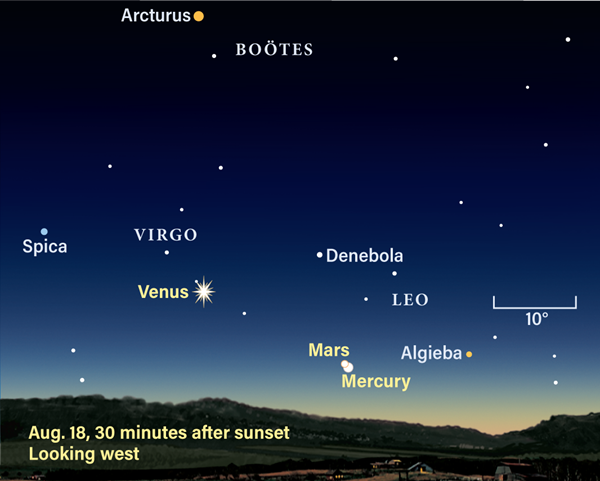Wednesday, August 18
Mercury will pass 0.08° south of Mars at midnight EDT in a close conjunction. Neither planet is visible at that time, however, so instead, catch them just after sunset, when they are low in the west and nearly as close: about 0.1° apart. Home in on the pair with binoculars or a telescope to better see Mercury, magnitude –0.6, to the lower right (west) of Mars, magnitude 1.8. Be quick, though, as the two planets set within an hour of the Sun. (Take care to never use binoculars or a telescope while the Sun is still in the sky, as the chances for accidentally pointing them at the Sun are still high.)
20.5° farther west of the pair is brilliant Venus, blazing at magnitude –4 in Virgo. Venus remains visible for longer, finally sinking blow the horizon around 9:30 P.M. local time. It sits within 7.5° of Porrima, also known as Gamma (γ) Virginis, a beautiful binary system in which each star is roughly the mass of the Sun. These near-twin stars are separated by just over 3″, with only 0.1 magnitude difference in brightness.
If you’re planning to stay up late to observe, you’ll want to set Jupiter — now located at the border between Aquarius and Capricornus) — in your sights around midnight EDT.
At that time, the Galilean moons Io and Ganymede sit just 8″ from Jupiter’s western limb. Io’s shadow passes in front of and slightly dims Ganymede between 12:15 A.M. and 12:34 A.M. EDT (on the 19th; late Aug. 18 in all other U.S. time zones). Two minutes after the event ends, Io slips into Jupiter’s long, dark shadow. Ganymede follows suit, disappearing 7 minutes later.
Meanwhile, as these events are proceeding, Europa begins a transit across the disk on the planet’s eastern side at 12:37 A.M. EDT. Its shadow precedes it onto the cloud tops by 3 minutes.
Sunrise: 6:15 A.M.
Sunset: 7:52 P.M.
Moonrise: 5:30 P.M.
Moonset: 1:40 A.M.
Moon Phase: Waxing gibbous (83%)










